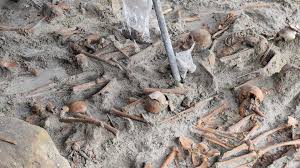The Office on Missing Persons (OMP) said from the 18th to the 20th December 2018, it has observed the process of selecting six bone samples for radio carbon dating at the Mannar mass grave, located at the Sathosa Building in Mannar town (Case No B/232/2018).
The process of selecting samples was carried out at the excavation site under the auspices of the Mannar Magistrate, Honourable T. Saravanaraja.
The team carrying out the sample selection included representatives from the Consultant Judicial Medical Officers, the Post Graduate Institute of Archaeology from the University of Kelaniya, the Police (Scene of Crime Officers – SOCO and crime investigation branch), and the Government Analysts Department.
OMP Commissioners Mr. Mirak Raheem and Mr. K. Venthan were present as observers. Lawyers representing families of the disappeared and a member from the Citizens’ Committee were also present as observers.
Radio carbon dating calculates the amount of Carbon-14 in bone and teeth samples and establishes the approximate time when an animal or plant was alive. It is a form of testing used in archaeology and forensic science for dating human remains.
The samples from the Mannar mass gravesite will be sent to a laboratory abroad which specializes in bomb pulse carbon 14 technique. In cases where the skeletons belonged to persons that died after World War II, bomb pulse carbon 14 dating can provide a narrower range of time periods in which the deaths occurred.
The Consultant Judicial Medical Officer, District General Hospital Mannar, Dr Shaminda Rajapaksha noted that after 118 working days 278 skeletons, which includes remains of men, women and children have been unearthed.
“There are some damages to the bones, but it is only upon further investigation that we can determine if these are ante mortem or post mortem injuries, and whether it relates to the cause of death. Our task has been to gather evidence to determine the cause of death, time since death, the contributing circumstances and the specific identity of the individuals in this site, and also determine if all the skeletons are from the same historical period or different periods, while ensuring the integrity of the site and chain of custody of remains and other evidence,” Dr Rajapaksha said.
Dr Shaminda Rajapaksha heads the investigation team and is assisted by Professor Raj Somadeva who leads the archaeological team.
Six samples were selected to represent the different areas and vertical layers of the site. Human remains had been excavated from the site as complete skeletons and as comingled bones. From complete skeletons, a tooth and a section of the femur bone was selected. From the comingled bones only the femur or where it was unavailable a tooth. The samples were extracted, cleaned, dried, sealed and labelled over the course of three days.
Following the samples being tested at a laboratory and the results being submitted, a preliminary combined excavation report including the test results and other findings will be submitted by the investigation team to the Magistrate Court.
The OMP was established under the Office on Missing Persons (Establishment, Administration and Discharge of Functions) Act No 14 of 2016, and has a primary mandate to search for and trace missing persons. Under its investigative powers, the OMP has the authority to apply to a Magistrate’s Court to act as an observer at excavations and exhumations of suspected grave sites [Section 12(d)].
The OMP’s application to act as an observer was accepted by the Honourable Mannar Magistrate on 4th June 2018, and it has been observing the process of excavation since.
The OMP will provide financial assistance to carry out carbon dating as part of its continued support to the investigation. Prior to the sampling process, the OMP recommended guidelines for selecting and recording the samples.
The OMP emphasized the need to ensure representatives of families of the disappeared and missing at the time of selecting samples to ensure accountability and transparency of the process. Further, the OMP recommended measures to secure the chain of custody of samples.
Chairperson of the OMP, Mr. Saliya Pieris, stated that “The OMP remains committed to establishing the truth about circumstances in which persons went missing and their fate. It is imperative for the OMP to assist the investigation of the remains excavated at the Mannar mass grave.”
Since July 2018, the OMP has been supporting the costs of food and lodgings of the excavation team and provided additional funds for covers to protect the grave site from the monsoon rain. “We have sought to impress on the authorities the need to maintain high standards and ensure public confidence and trust in the investigation process” Mr. Pieris added.
Courtesy: Colombo Page


